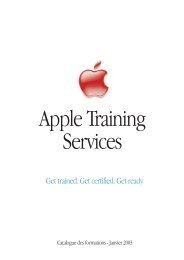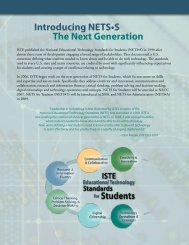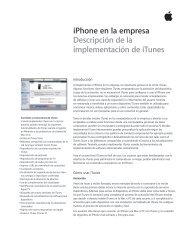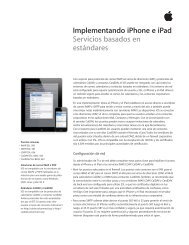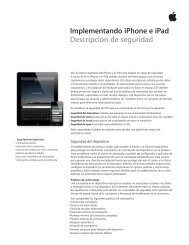Apple Classrooms of Tomorrow (ACOT)
Apple Classrooms of Tomorrow (ACOT)
Apple Classrooms of Tomorrow (ACOT)
Create successful ePaper yourself
Turn your PDF publications into a flip-book with our unique Google optimized e-Paper software.
APPLE CLASSROOMS OF TOMORROW<br />
Authors<br />
Cathy Ringstaff<br />
Keith Yocam<br />
<strong>Apple</strong> Computer, Inc.<br />
Jean Marsh<br />
Independent<br />
Educational Researcher<br />
<strong>ACOT</strong> Report #22<br />
Integrating Technology<br />
into Classroom Instruction:<br />
An Assessment <strong>of</strong> the<br />
Impact <strong>of</strong> the <strong>ACOT</strong> Teacher<br />
Development Center Project<br />
Research
<strong>Apple</strong><br />
SM<br />
<strong>Classrooms</strong> <strong>of</strong> <strong>Tomorrow</strong> (<strong>ACOT</strong> )<br />
is a collaboration—initiated in 1985—<br />
among public schools, universities, research<br />
agencies, and <strong>Apple</strong> Computer, Inc. In <strong>ACOT</strong><br />
classrooms, students and teachers have immediate<br />
access to a wide range <strong>of</strong> technologies, including<br />
computers, videodisc players, video cameras, scanners,<br />
CD-ROM drives, modems, and on-line communications<br />
services. In addition, students can use an<br />
assortment <strong>of</strong> s<strong>of</strong>tware programs and tools, including<br />
word processors, databases, spreadsheets, and<br />
graphics packages. In <strong>ACOT</strong> classrooms, technology<br />
is viewed as a tool for learning and a medium for<br />
thinking, collaborating, and communicating.<br />
<strong>ACOT</strong>’s research has demonstrated that the<br />
introduction <strong>of</strong> technology to classrooms can significantly<br />
increase the potential for learning, especially<br />
when it is used to support collaboration, information<br />
access, and the expression and representation<br />
<strong>of</strong> students’ thoughts and ideas.<br />
Realizing this opportunity for all students,<br />
however, requires a broadly conceived approach<br />
to educational change that integrates new technologies<br />
and curricula with new ideas about learning<br />
and teaching, as well as with authentic forms<br />
<strong>of</strong> assessment.<br />
Acknowledgment<br />
The authors would like to acknowledge the assistance <strong>of</strong><br />
Jane David, who serves as a research advisor for this project.<br />
Her help in conceptualizing the research, as well as in organizing<br />
and editing this report, has been invaluable. We<br />
would also like to thank the case study teachers, the Teacher<br />
Development Center coordinators, the <strong>ACOT</strong> teachers, the<br />
steering committee, and all project participants at each site<br />
for their cooperation. Without their patience and support,<br />
this research could not have been conducted.
This report presents research<br />
findings from Year Two <strong>of</strong> the<br />
<strong>ACOT</strong> Teacher Development<br />
Centers project, a model <strong>of</strong> teacher<br />
development that goes beyond the<br />
traditional teacher in-service experience.<br />
Participating teachers learn<br />
by observing and working extensively<br />
with accomplished <strong>ACOT</strong><br />
teachers and students during<br />
actual school days.<br />
Abstract<br />
With support from the National Science Foundation, the <strong>ACOT</strong> Teacher Development<br />
Center project creates a new model <strong>of</strong> teacher development, situated in a<br />
context <strong>of</strong> practice and utilizing the expertise <strong>of</strong> accomplished classroom teachers.<br />
This report presents research findings from Year Two <strong>of</strong> the <strong>ACOT</strong> Teacher Development<br />
Centers. Following an overview <strong>of</strong> the project and research methods is a<br />
description <strong>of</strong> the variety <strong>of</strong> ways in which participating teachers report changes in<br />
their instruction and in their roles, particularly in sharing their new knowledge with<br />
colleagues. Finally, we describe some <strong>of</strong> the factors that influence the extent to which<br />
participating teachers change their practices, including features <strong>of</strong> the project and<br />
features <strong>of</strong> their school environment that facilitate or hinder instructional change.<br />
Project Overview<br />
In September 1992, <strong>Apple</strong> <strong>Classrooms</strong> <strong>of</strong> <strong>Tomorrow</strong> (<strong>ACOT</strong>), the National Science<br />
Foundation, and the school districts <strong>of</strong> Columbus, Ohio; Cupertino, California; and<br />
Nashville, Tennessee joined to create the <strong>ACOT</strong> Teacher Development Center<br />
project. The project creates <strong>ACOT</strong> Teacher Development Centers in each site that<br />
prepare participating teachers to do the following:<br />
■ Create inquiry-based, collaborative, and knowledge-building tasks focused on<br />
math, science, history, and language arts.<br />
■ Use a wide variety <strong>of</strong> technologies as tools that support learning through composition,<br />
collaboration, simulation, and guided practice.<br />
■ Implement a portfolio assessment strategy that includes both student products<br />
and performance samples and that increases students’ involvement in, and reflection<br />
about, their own learning process.<br />
The <strong>ACOT</strong> Teacher Development Center project <strong>of</strong>fers a model <strong>of</strong> teacher<br />
development that goes beyond the traditional teacher in-service experience. Participating<br />
teachers learn by observing and working extensively with accomplished <strong>ACOT</strong><br />
teachers and students during actual school days. <strong>ACOT</strong> calls this situated teacher<br />
development, because participating teachers are situated in a context <strong>of</strong> practice.<br />
<strong>ACOT</strong> Teacher Development Centers also differ from traditional forms <strong>of</strong><br />
staff development because activities are learner-centered and interactive. The design<br />
<strong>of</strong> the <strong>ACOT</strong> Teacher Development Center is based on the premise that learning<br />
should take place in an environment that provides learners—students and teachers—<br />
with the opportunity to construct and interpret meaning for themselves, rather than<br />
in an environment where a teacher only “transmits” information to learners. In this<br />
type <strong>of</strong> environment, learners have more ownership <strong>of</strong>, and responsibility for, their<br />
learning. The Teacher Development Center project’s constructivist design models<br />
the types <strong>of</strong> learning environment implemented in <strong>ACOT</strong> classrooms.<br />
<strong>ACOT</strong> Teacher Development Centers were established in three schools where<br />
<strong>ACOT</strong> has already made major investments in technology, teacher support, and pr<strong>of</strong>essional<br />
development: Stevens Creek Elementary School (K–6), Cupertino, California;<br />
West High School (9–12), Columbus, Ohio; and Dodson Elementary School<br />
(K–5), Nashville, Tennessee.<br />
The <strong>ACOT</strong> Teacher Development Center program has three major components:<br />
weeklong practicums during the school year that introduce teachers to new<br />
APPLE CLASSROOMS OF TOMORROW Integrating Technology into Classroom Instruction 1
The program has three major components:<br />
practicums during the<br />
school year, summer leadership<br />
institutes, and follow-up support.<br />
Technology plays a central role—<br />
as catalyst and tool for instructional<br />
change—yet the purpose<br />
<strong>of</strong> the program goes well beyond<br />
teaching specifics about hardware<br />
and s<strong>of</strong>tware use.<br />
instructional tools and strategies in working classrooms; four-week summer leadership<br />
institutes that provide the same introductions to new techniques with added<br />
time for practice, reflection, and preparation <strong>of</strong> strategies to engage additional teachers<br />
from participants’ schools in development activities; and follow-up support extended<br />
by <strong>ACOT</strong> Teacher Development Center coordinators on an ongoing basis for<br />
one year following teacher attendance at a practicum and/or summer institute. Both<br />
the practicums and the summer institutes require participants to implement projects<br />
in their own classrooms.<br />
Although the specifics <strong>of</strong> the curriculum for participants differ from week to<br />
week and from site to site based on the interests and background <strong>of</strong> participating<br />
teams and the students, all participants do the following:<br />
■ Observe and reflect on a variety <strong>of</strong> teaching strategies, including direct instruction,<br />
team teaching, collaborative learning, project-based learning, and interdisciplinary<br />
learning.<br />
■ Use computers, productivity s<strong>of</strong>tware, camcorders, and telecommunications as<br />
tools to support learning.<br />
■ Interact with students in real classrooms.<br />
■ Share knowledge and experience with colleagues.<br />
■ Read and discuss pertinent research literature.<br />
■ Create specific plans for technology use in their own classrooms and schools.<br />
Technology plays a central role in the <strong>ACOT</strong> Teacher Development Centers, as<br />
catalyst and tool for instructional change. Yet the purpose <strong>of</strong> the program goes well<br />
beyond teaching specifics about hardware and s<strong>of</strong>tware use. Many <strong>of</strong> the skills and<br />
teaching techniques used are applicable in classrooms that have minimal technology.<br />
<strong>ACOT</strong> Teacher Development Center coordinators facilitate the exploration <strong>of</strong> issues<br />
including the design <strong>of</strong> challenging learning tasks; purposeful student interactions;<br />
flexible, authentic learning situations; the use <strong>of</strong> an array <strong>of</strong> technology tools; and the<br />
importance <strong>of</strong> alternative forms <strong>of</strong> student assessment.<br />
To participate, teachers are required to have access to at least one computer, a<br />
printer, and appropriate s<strong>of</strong>tware to assist them as they learn to integrate technology<br />
in their regular classroom. Moreover, teachers are required to attend in teams <strong>of</strong> two<br />
or four so that they can support one another when they return to their schools.<br />
Finally, the principal’s commitment to, and involvement in, a changing vision <strong>of</strong><br />
learning and instruction is considered critically important to the success <strong>of</strong> this program.<br />
Hence, principals are encouraged to attend selected portions <strong>of</strong> the program<br />
with their teachers. Furthermore, principals must agree to do the following:<br />
■ Release teachers from their regular classrooms to participate.<br />
■ Provide teachers with the authority and flexibility to adjust daily instructional<br />
schedules and to develop curriculum objectives that promote team teaching<br />
and interdisciplinary instruction.<br />
■ Allow time each day for teachers to meet and plan.<br />
■ Provide time for teachers to reflect on their practice.<br />
■ Acknowledge the importance <strong>of</strong> the team’s efforts to the rest <strong>of</strong> the staff.<br />
2 Integrating Technology into Classroom Instruction APPLE CLASSROOMS OF TOMORROW
The researchers observed at each<br />
site, interviewed the coordinators<br />
and examined their weekly reports,<br />
queried all participants via questionnaire,<br />
and collected extensive<br />
data (via interview, observation,<br />
and journal entries) from a<br />
selected group <strong>of</strong> Year One<br />
participants.<br />
Overview <strong>of</strong> Research Methodology<br />
The Year Two research agenda was designed to track participation, to document the<br />
evolution <strong>of</strong> the <strong>ACOT</strong> Teacher Development Centers at each site, and, especially,<br />
to describe the program’s impact on teachers who participated during the project’s<br />
first year. (For a fuller description <strong>of</strong> the program during Year One, see <strong>ACOT</strong> Report<br />
#18, “Creating an Alternative Context for Teacher Development: The <strong>ACOT</strong> Teacher<br />
Development Centers.”)<br />
To document the continuing evolution and refinement <strong>of</strong> the centers, the<br />
research team observed each site during practicums and summer leadership institutes,<br />
examined site coordinators’ weekly reports, and periodically interviewed the<br />
coordinators. Researchers also obtained data from participants and coordinators<br />
via questionnaires.<br />
To learn the ways in which the <strong>ACOT</strong> Teacher Development Centers influenced<br />
participants, we asked first-year participants to respond to a follow-up questionnaire<br />
toward the end <strong>of</strong> the second year <strong>of</strong> the project. The questionnaire asked<br />
teachers to comment on the success <strong>of</strong> the technology project they had planned<br />
while at the center, and to describe any changes they had made in their teaching<br />
that they could attribute to having attended a practicum and/or summer leadership<br />
institute.<br />
Additionally, we conducted phone interviews with principals who had sent<br />
teachers to the <strong>ACOT</strong> Teacher Development Centers. Principals were asked to describe<br />
any changes they had noticed in participating teachers after they had attended<br />
the Teacher Development Center, as well as any impact on the school.<br />
To investigate the impact <strong>of</strong> the project on participants in greater depth, we<br />
selected nine teachers who attended the first-year Summer Leadership Institute to<br />
serve as case studies. Three at each site were chosen, to represent a range <strong>of</strong> grade<br />
levels, teaching experience, and technological expertise. We further constrained the<br />
selection to ensure that their schools represent a range <strong>of</strong> contexts in terms <strong>of</strong> student<br />
socioeconomic status and amount <strong>of</strong> technology available.<br />
Over the course <strong>of</strong> the 1993–94 academic year, information was gathered on<br />
the nine case study teachers through periodic classroom observations <strong>of</strong> their teaching,<br />
regular interviews, and audiotape journals in which they reflected on their use <strong>of</strong><br />
technology, their ideas about teaching, and classroom and school events. Additional<br />
data were gathered about the case study teachers and their schools through interviews<br />
with other teachers and administrators at the school site.<br />
Effects on Participating Teachers<br />
Teachers who attended either a practicum or summer institute reported an array <strong>of</strong><br />
new attitudes and behaviors, including changes in beliefs about instruction as well<br />
as changes in instructional practices and uses <strong>of</strong> technology in their classrooms. In<br />
addition, participants took on a range <strong>of</strong> new leadership roles in their own schools<br />
and in their districts.<br />
Analyses <strong>of</strong> the case study and questionnaire data suggest that instructional<br />
changes in classrooms occurred in three major areas: classroom organization, level<br />
<strong>of</strong> use <strong>of</strong> technology by both students and participants, and participants’ philosophical<br />
beliefs and attitudes toward teaching.<br />
APPLE CLASSROOMS OF TOMORROW Integrating Technology into Classroom Instruction 3
Participants reported that they<br />
were influenced by the various<br />
teaching strategies they observed,<br />
such as cooperative learning or<br />
interdisciplinary units, to begin<br />
using new strategies in their<br />
own classrooms.<br />
In addition to making changes in their classrooms, participants also took on<br />
new roles outside their classrooms. Many shared what they learned with colleagues.<br />
Others went a step further, and took on more formal leadership roles, influencing<br />
their school’s climate and vision for the future. These new roles are described below,<br />
following the discussion <strong>of</strong> changes in classrooms.<br />
Changes in Instructional Practices<br />
Participants in the Teacher Development Centers had opportunities to observe and<br />
reflect on a variety <strong>of</strong> teaching strategies, including direct instruction, team teaching,<br />
collaborative learning, project-based learning, and interdisciplinary learning, as well<br />
as ways in which technology can support different strategies. They report a variety <strong>of</strong><br />
ways in which their instruction has been influenced by these experiences, including<br />
changes in classroom organization, in uses <strong>of</strong> technology, and, perhaps most powerfully,<br />
in their beliefs about instruction, their students, and themselves.<br />
Changes in Classroom Organization. Teachers report changes both in how they<br />
organize students for instruction and in the instructional strategies they utilize. Some<br />
teachers have begun using cooperative learning for the first time. Others have<br />
started implementing student projects. Still others are learning how to teach using<br />
interdisciplinary, thematic units. As one teacher stated,<br />
A way I have changed, and I credit that to <strong>ACOT</strong>, is I take the unit as a whole<br />
and try to involve them in the big picture more than just, “Let’s read lesson so<br />
and so today and learn what’s in that.”<br />
Even teachers already using collaborative teaching sometimes altered their instructional<br />
techniques:<br />
What changed was what we do in those groups and how we present our<br />
lessons in those groups. We didn’t necessarily do a unit and have students<br />
present it to each other before that.<br />
Participants report more use <strong>of</strong> the “station approach,” in which groups <strong>of</strong><br />
students rotate through a variety <strong>of</strong> different activities on a daily or weekly basis.<br />
Teachers find this strategy particularly useful when technology is limited. Although<br />
teachers report that planning for this approach is labor-intensive, they find that students<br />
respond well to this structure and that it ensures more equal access to the<br />
technology.<br />
Often, as teachers acquire more technology, they increase the number <strong>of</strong><br />
stations utilizing technology. One case study teacher, for example, after seeing what<br />
another participant had accomplished with a single computer station, decided to<br />
integrate technology stations into a unit on Japan. Over the course <strong>of</strong> the unit, students<br />
used a CD-ROM player, laserdisc player, and VCR, as well as a HyperCard ®<br />
stack<br />
sent by a Japanese high school.<br />
Changes in Technology Use. Not surprisingly, questionnaire responses indicate that<br />
the major influence <strong>of</strong> the Teacher Development Center program has been on the<br />
nature and level <strong>of</strong> technology use in participants’ classrooms. About 60 percent <strong>of</strong><br />
4 Integrating Technology into Classroom Instruction APPLE CLASSROOMS OF TOMORROW
Participants also reported using<br />
technology differently—reducing<br />
the use <strong>of</strong> drill-and-practice s<strong>of</strong>tware,<br />
increasing the use <strong>of</strong> tools<br />
such as databases and spreadsheets,<br />
and introducing telecommunications<br />
into lessons. And<br />
participants also reported that<br />
these changes have led to higher<br />
levels <strong>of</strong> student motivation,<br />
interest, and engagement.<br />
the respondents said that the most important lesson or idea they had learned from<br />
the program was technology-related, including how to use specific hardware or<br />
s<strong>of</strong>tware, or general ideas about the power <strong>of</strong> technology for instruction. Their examples<br />
illustrate the goals <strong>of</strong> the project—to integrate technology into instruction<br />
and use it to support learning goals, not as an end in itself.<br />
Teachers who came into the program with some technological expertise<br />
began using technology for different purposes in their classrooms. Some, for example,<br />
reduced the use <strong>of</strong> drill-and-practice s<strong>of</strong>tware in favor <strong>of</strong> more sophisticated<br />
tools such as databases and spreadsheets. Many report that, as a result <strong>of</strong> their own<br />
participation in the project, their students are “getting on the computer more” than<br />
ever before.<br />
Even participants who were already using computers fairly extensively in their<br />
classrooms came back from the program with new skills and ideas. One case study<br />
teacher, for example, began new projects using telecommunications—a tool she had<br />
never used before. Students in her classroom began communicating with children<br />
in Japan and Nova Scotia, as well as with a pr<strong>of</strong>essor <strong>of</strong> Shakespeare in New Mexico.<br />
Through the use <strong>of</strong> telecommunications, the case study teacher was also able to<br />
acquire shareware that fits into her social studies and language arts curriculum.<br />
Novice technology users report returning to their classrooms with a greater<br />
level <strong>of</strong> comfort. As one participant commented,<br />
I was a nonuser <strong>of</strong> computers. Turning one on took major effort. Now I can<br />
use one well enough to use for classroom use, as well as help students do<br />
essays, etc. on them.<br />
Other novice users report that they are using their school’s computer lab<br />
differently. At one school, for example, a participant commented that she now goes<br />
with her students to the lab, rather than “sending them there and having them work<br />
with another adult.” Because <strong>of</strong> this new comfort level with computers, novice users<br />
with access to a lab are more apt to take the next step and begin integrating technology<br />
into instruction, rather than using the lab to “teach computers.”<br />
In addition to gaining skills in using specific hardware and s<strong>of</strong>tware, teachers<br />
also returned to their classrooms with more knowledge about the types <strong>of</strong> technology<br />
available. They were <strong>of</strong>ten inspired to purchase equipment for their own homes<br />
and classrooms. Some teachers spent personal funds to obtain new equipment,<br />
while others began their own fund-raising projects.<br />
Teachers report that their changes in teaching strategies and use <strong>of</strong> technology<br />
have led to higher levels <strong>of</strong> student motivation, interest, and engagement. Students<br />
are writing more, reported a number <strong>of</strong> teachers, both on the computer and with<br />
paper and pencil. Peer relations have also improved in some classrooms. As one<br />
teacher reported, “Technology gets students turned on and it gets them pulling<br />
together and working as a team much more effectively than anything else.”<br />
The effect on students in special education classrooms was particularly noteworthy,<br />
and sometimes surprised their teachers. In one classroom, the teacher<br />
found that her special education students were more willing to read in order to<br />
complete their projects than in traditional reading groups. A preschool teacher <strong>of</strong><br />
children with special needs reported:<br />
APPLE CLASSROOMS OF TOMORROW Integrating Technology into Classroom Instruction 5
Describing the impact <strong>of</strong> the project<br />
on themselves, participants reported<br />
excitement as well as an<br />
increase in personal motivation<br />
and power. Many began to view<br />
themselves as learners again, and<br />
became more willing to take risks.<br />
They also gained new insight into<br />
students’ capabilities.<br />
Technology has literally changed the flavor <strong>of</strong> my classroom. It’s such a motivator<br />
for my special needs children, and I am getting oral language from<br />
children who were previously nonverbal. . . My kids just love it! They love<br />
being in control, they develop a sense <strong>of</strong> autonomy, competence, and soon<br />
begin relating with peers, giving them a sense <strong>of</strong> belonging.<br />
Philosophical and Attitudinal Changes. The most lasting impact <strong>of</strong> teachers’<br />
experiences in the Teacher Development Centers may prove to be changes in their<br />
attitudes toward teaching, their feelings <strong>of</strong> self-efficacy, and their beliefs about their<br />
students, which in turn influence their instructional practices.<br />
Coordinators, principals, and teachers alike reported that participants commonly<br />
returned to their schools “all fired up.” Along with the excitement came an<br />
increase in teacher motivation and morale. One case study teacher—a veteran <strong>of</strong> 25<br />
years—said <strong>of</strong> the practicum: “It totally rejuvenated me. . . Now, I can’t retire!”<br />
Consistent with research conducted on the Teacher Development Center<br />
pilot project (Marsh & Sherwood, 1991), some teachers also reported an increase<br />
in feelings <strong>of</strong> self-efficacy and personal empowerment when they returned to their<br />
classrooms. One teacher stated, for example,<br />
I gained from the training a feeling <strong>of</strong> excitement and one <strong>of</strong> being capable.<br />
I gained a sense <strong>of</strong> accomplishment. A feeling that helped me try new and<br />
exciting ways to use technology.<br />
Many teachers also began to view themselves as learners again, and became<br />
more willing to take risks. Sometimes the risk involved trying a new lesson, or using<br />
a new piece <strong>of</strong> technology. But <strong>of</strong>ten the risk involved changes on a deeper, more<br />
philosophical level, such as a willingness to change the student/teacher relationship.<br />
One teacher, for example, said that the most important lesson she learned at the<br />
Center was:<br />
Being able to say, “I don’t know, let’s try it” to the students when they ask if<br />
something can be done. . . I don’t always need an answer for every question<br />
a child asks. We can discover the answer together.<br />
Becoming a learner again also led some teachers to reflect on their teaching<br />
techniques and to question the value <strong>of</strong> what they were doing in their classrooms.<br />
“Putting the shoe on the other foot” gave teachers the opportunity to see the value<br />
<strong>of</strong> changing to a more constructivist teaching approach. One teacher reflected,<br />
I was a wonderful presenter. I was the one doing all <strong>of</strong> the work, and consequently,<br />
most <strong>of</strong> the learning. Sure, my students memorized the facts for the<br />
test. But I wonder now how many <strong>of</strong> them care about really learning anything.<br />
I find it hard, now, to believe that I expected all those kids to sit in a<br />
desk all day long and listen to me.<br />
Teachers not only viewed themselves differently after attending the program,<br />
but <strong>of</strong>ten saw their students in a new light. As they observed and worked with<br />
students at the center, participants realized that the children <strong>of</strong>ten knew more than<br />
they did about technology—and certainly learned new technology skills faster than<br />
6 Integrating Technology into Classroom Instruction APPLE CLASSROOMS OF TOMORROW
Upon returning to their schools,<br />
many participants began sharing<br />
their new skills and ideas. They<br />
conducted workshops and presentations<br />
for colleagues or designed<br />
projects that involved the entire<br />
school in using technology.<br />
many adults. Teachers <strong>of</strong>ten returned to their classrooms with higher expectations<br />
for their students, as this quote from one coordinator illustrates:<br />
Before Mrs. Smith’s study in <strong>ACOT</strong>, students used computers for drill and<br />
practice. They were not allowed to place s<strong>of</strong>tware in the computers and<br />
always wrote on paper first and then typed their information using the computer.<br />
They never had the opportunity to print. Today, students compose on<br />
the computer and print their work.<br />
As teachers gained new insight into students’ capabilities, they <strong>of</strong>ten began<br />
treating them with more genuine respect. As the principal <strong>of</strong> one case study teacher<br />
noted, “What has changed in her classroom is that the kids have more input and<br />
decision-making power.”<br />
New Roles for Teachers<br />
Teachers as Staff Developers and Technology Trainers. Upon returning to their<br />
schools, many participants began sharing their new skills and ideas with colleagues.<br />
Teachers conducted mini-workshops and in-services, made presentations to faculty<br />
members and parents’ groups, and held open houses where they demonstrated<br />
their new skills with the technology. Many teachers seemed anxious to “spread the<br />
word” to others, even when it meant working increasingly long hours before and<br />
after school. As one case study teacher stated, “I see my job as continuing to help<br />
other teachers and sharing with them what I’ve done.”<br />
Participants are sharing their expertise not only with other teachers, but also<br />
with students. At one school, a participant held after-school sessions for 15 weeks,<br />
training teachers and two students from every class on computer basics, curriculum<br />
integration, and different s<strong>of</strong>tware programs. At another school, two teachers taught<br />
students in the gifted program how to use technology, including HyperStudio and<br />
camcorders, over a four-day period. The students then taught their peers in other<br />
classrooms. Based on the enthusiastic response to this project, the teachers were<br />
able to convince the principal to buy a site license for HyperStudio, which they are<br />
planning to integrate into the science curriculum.<br />
Some teachers have designed projects that involve the entire school in learning<br />
technology. One teacher, for example, gathered all the computers that teachers<br />
weren’t using and made a lab in the library. The entire school began funneling<br />
through the lab to work on keyboarding.<br />
Another common way participants have found to share their expertise with<br />
other teachers and students is by creating “buddy projects.” One case study teacher,<br />
for example, took computers into the library and paired the fourth-graders with the<br />
first-graders, and the second-graders with the third-graders.<br />
Participants have also managed to get parents and other community members<br />
involved in using technology. One school media specialist decided to train parents<br />
to help in the library and in classrooms. At another school, participants organized a<br />
multimedia fair that was open to the community. This event was so well attended<br />
that participants are planning to have an even bigger fair next year.<br />
Participants also created less formal strategies for sharing what they had<br />
learned at the Teacher Development Centers. These strategies were particularly<br />
APPLE CLASSROOMS OF TOMORROW Integrating Technology into Classroom Instruction 7
Principals reported that participants<br />
took on leadership roles,<br />
for example, forming or joining<br />
a technology committee, advising<br />
on technology spending, and writing<br />
grant proposals to acquire<br />
more technology.<br />
useful for enticing reluctant teachers into the world <strong>of</strong> technology. Several case study<br />
teachers, for example, put up bulletin boards in the halls to show others how technology<br />
was used in their classrooms. They found that the bulletin boards “really<br />
seemed to get lots <strong>of</strong> teachers interested to see what we were doing.”<br />
Another case study teacher took a “minimalist” approach to working with his<br />
colleagues. Rather than trying to impress them by demonstrating the most sophisticated<br />
uses <strong>of</strong> technology he had learned, he decided to “show exactly the lowest<br />
level <strong>of</strong> what you can do for yourself on the Macintosh ®.” By informally showing four<br />
or five teachers “the bare minimum facts” <strong>of</strong> how to set up the computer to produce<br />
a newsletter, he hooked teachers into learning more. He said,<br />
They realized a lot <strong>of</strong> it is very easy. I had more teachers come back to me<br />
and say, “Gosh, this was the first time we’ve ever had anybody sit down and<br />
slowly explain it to us.”<br />
Participants also found that “word <strong>of</strong> mouth” was an effective way <strong>of</strong> creating<br />
interest in technology use. For example, after inviting a few teachers into her classroom<br />
to observe a lesson using technology, one case study teacher found that others<br />
were coming in to watch and to borrow equipment. Principals who were interviewed<br />
during the second year <strong>of</strong> the project repeatedly commented that participants “got<br />
the ball rolling” toward change, and that teachers who had never expressed interest<br />
in technology before were beginning to “jump on the bandwagon.”<br />
Teachers as School Leaders and Entrepreneurs. Interviews with principals suggest<br />
that, upon returning to their schools, participants <strong>of</strong>ten took on leadership roles<br />
within their schools that ultimately affected the school’s climate and mission. After<br />
visiting the Teacher Development Center, teachers wanted more training and<br />
more technology for their classrooms, and used a variety <strong>of</strong> strategies to get what<br />
they wanted.<br />
Some teachers joined or formed a school technology committee, and began<br />
to push their colleagues to create a shared vision for technology use throughout the<br />
school. In some cases, technology committees were instrumental in finding local<br />
organizations to help fund technology acquisition or in organizing fund-raising efforts.<br />
A number <strong>of</strong> participants were successful in convincing parent groups to earmark<br />
their funds for technology rather than for other purposes. Said one principal,<br />
There used to be a lot <strong>of</strong> resistance in the PTA toward computers. Now the<br />
attitude has changed.<br />
Principals also began looking to participants for assistance in making decisions<br />
related to technology purchasing and acquisition. When there was no money in the<br />
school’s existing budget to purchase technology or to <strong>of</strong>fer staff development in<br />
technology use, participants persuaded principals to redirect funds that had been<br />
earmarked for other purposes. At one school, for example, the principal used funds<br />
from a program for gifted students to hire substitutes for the Teacher Development<br />
Center participants, who wanted time away from their regular classroom duties to<br />
teach the gifted students how to use technology. Other principals have used funding<br />
from state and federal programs in creative ways to buy equipment and to pay for<br />
8 Integrating Technology into Classroom Instruction APPLE CLASSROOMS OF TOMORROW
Participants reported making presentations<br />
and helping to teach<br />
workshops, noting that the project<br />
has begun to have an impact on<br />
their communities and districts<br />
as well as on their schools.<br />
pr<strong>of</strong>essional development. For example, one case study school received permission<br />
to use Chapter I monies to purchase technology.<br />
A number <strong>of</strong> participants at each <strong>of</strong> the sites have become actively involved in<br />
writing grant proposals to acquire more technology and have been extremely successful<br />
in obtaining small grants from local foundations as well as larger district and<br />
state grants. At one site, for example, <strong>ACOT</strong> participants were involved in 10 <strong>of</strong> the<br />
15 proposals winning district incentive grants and in 14 <strong>of</strong> the state-funded 21st<br />
Century grants.<br />
According to principals at some <strong>of</strong> these schools, the grant proposals probably<br />
would not have been written if the Teacher Development Center participants<br />
“hadn’t insisted on it.” Participants agreed:<br />
My exposure to <strong>ACOT</strong>, along with several coworkers, led to major changes in<br />
our school’s technological future. We have gotten over $200,000 worth <strong>of</strong><br />
technology for our school in the past year through grants and PTA support.<br />
This has been a direct result <strong>of</strong> <strong>ACOT</strong> exposure.<br />
We applied for and have received a $50,000 grant to equip the classroom.<br />
Prior to attending the <strong>ACOT</strong> Teacher Development Center, I would never<br />
have dared to dream so big or known how to try to accomplish my dream!<br />
Teachers as District Leaders. In addition to having an impact on individual teachers<br />
and their schools, the program is also having an impact on the districts—and even<br />
the states—in which the centers are located. <strong>ACOT</strong> teachers and coordinators are<br />
being recognized for their expertise, and administrators at the school and district<br />
levels are seeking their advice. Coordinators have been asked to join a variety <strong>of</strong><br />
technology committees at the state and district level. At several sites, coordinators<br />
also serve in an advisory capacity to local universities.<br />
At one site, plans are under way to expand the teacher development center<br />
to include the entire school, so more teachers from the district can be trained. This<br />
type <strong>of</strong> recognition, however, did not happen overnight. The coordinator explained,<br />
We waited a long time for the <strong>ACOT</strong> project to be appreciated in our own<br />
school system, but it is now clear the project is recognized as a vital force in<br />
bringing about change.<br />
Graduates <strong>of</strong> the Teacher Development Centers are also becoming district<br />
and community leaders. At one site, participants are helping teach district in-service<br />
workshops <strong>of</strong>fered on technology-related topics such as using district-licensed<br />
s<strong>of</strong>tware. Two other participants were invited to teach a technology-related summer<br />
school class for preservice teachers at a local university. Some participants have<br />
moved into administrative positions. Others have been asked to make presentations<br />
to principals’ groups, potentially influencing many schools.<br />
Influences on Participants’ Changing Practices<br />
The extent <strong>of</strong> changes in instruction and roles appears related to whether teachers<br />
attended the practicum or the summer institute, the nature <strong>of</strong> follow-up support<br />
they received, and conditions at their school. In particular, teachers were more likely<br />
to change instructional practices when they had attended both the practicum and<br />
APPLE CLASSROOMS OF TOMORROW Integrating Technology into Classroom Instruction 9
The researchers found that the extent<br />
<strong>of</strong> changes in instruction and<br />
roles appears related to whether<br />
teachers attended the practicum<br />
or the summer institute, the nature<br />
<strong>of</strong> follow-up support received, and<br />
conditions at the participants’<br />
school. Teachers were most likely<br />
to change instructional practices<br />
when they had attended both the<br />
practicum and the summer<br />
institute.<br />
the summer institute, and when they had follow-up support from the coordinator<br />
shortly thereafter. Similarly, instructional changes and sharing new knowledge with<br />
colleagues were more likely when the principal supported such change, when<br />
technical support was readily available, and when time was available for planning.<br />
Differences Between the Practicum and Summer Institute Experience<br />
Teachers who visit the <strong>ACOT</strong> Teacher Development Center can attend a practicum,<br />
a summer institute, or both program components. During the first two years <strong>of</strong> the<br />
program, teachers first attended the practicum, and then up to one-half <strong>of</strong> these<br />
participants could come back for the summer institute with a team member from<br />
their school who had not yet been to the center. Although we have not examined<br />
the impact <strong>of</strong> each component separately, the consensus from participants and<br />
<strong>ACOT</strong> staff supports the value <strong>of</strong> having both experiences, with differences <strong>of</strong><br />
opinion about preferred order.<br />
The practicum and the summer institute <strong>of</strong>fer different types <strong>of</strong> experiences<br />
for participants, both with distinct strengths and weaknesses. They differ in length<br />
(five days vs. four weeks) and in context (actual school-year classes vs. a voluntary<br />
summer program).<br />
The shorter length <strong>of</strong> the practicum forces coordinators to weigh more carefully<br />
decisions related to the breadth and depth <strong>of</strong> information and experiences.<br />
Typically, coordinators choose to provide an introduction to a wide variety <strong>of</strong> topics<br />
rather than in-depth study on one or two s<strong>of</strong>tware packages or teaching techniques.<br />
Consequently, the practicum <strong>of</strong>fers participants “a little bit about a lot,” which some<br />
described as “a smorgasbord” or “a teaser” that “whetted their appetite.” For a few,<br />
such an overview was frustrating because they expected to learn specific technologies.<br />
For many, however, the practicum experience led participants to apply for the<br />
summer institute.<br />
In contrast, participants in the summer institute not only had the luxury <strong>of</strong><br />
exploring a wide variety <strong>of</strong> topics, but also had the time to engage in more in-depth<br />
learning. The additional time also allowed the coordinators to modify their plans<br />
from day to day.<br />
The overriding strength <strong>of</strong> the practicum to participants is that it is situated in<br />
real <strong>ACOT</strong> classrooms during the school year. Class sizes are realistic, the curriculum<br />
is prescribed, and students are typically assessed by standardized achievement tests.<br />
Except for amount and variety <strong>of</strong> technology available, it represents the reality that<br />
all teachers face. The drawback is that, because it is “real” school, it <strong>of</strong>fers less time<br />
for interaction between <strong>ACOT</strong> teachers and participants. The practicum allows participants<br />
to see the possibilities in a context that is similar to their own classrooms,<br />
making what they learned easier to transfer to their own situations. Because school<br />
is in session during the practicums, teachers can return immediately to their classrooms<br />
and try what they have learned while their excitement and motivation are<br />
high. However, having school in session means that many practicum participants<br />
return to their classrooms in the evenings to make sure their classes were running<br />
smoothly, adding to their workload.<br />
In contrast, the summer institute <strong>of</strong>fers “the best <strong>of</strong> all worlds.” Class sizes<br />
are small, there are no curriculum mandates, and there are no standardized tests<br />
for students or teachers to worry about. The summer institute gives teachers the<br />
10 Integrating Technology into Classroom Instruction APPLE CLASSROOMS OF TOMORROW
Follow-up support from the coordinator,<br />
such as technical support<br />
and other kinds <strong>of</strong> assistance,<br />
was also a crucial factor in the<br />
change process.<br />
chance to work side by side with students and with <strong>ACOT</strong> teachers, to take risks,<br />
and to explore in a nonthreatening environment. In contrast, to participants in the<br />
practicums, summer institute participants feel much less time pressure. However,<br />
participants in the summer institutes must wait at least a month before trying their<br />
new ideas.<br />
The coordinators believe that teachers who attend only the summer institute<br />
are more likely to make changes in their classrooms than those who attend only the<br />
practicum. Coordinators also report that summer institute participants tend to be<br />
much farther ahead than those who only attended the practicum, more likely to take<br />
on active leadership roles, and less likely to give up when they run into problems.<br />
Many participants who attended a practicum and the summer institute felt that<br />
attending both program components was extremely valuable and that they complemented<br />
each other. One teacher stated, “I believe that for someone without the<br />
practicum, the summer institute would be overwhelming.” Coordinators agreed that<br />
the practicum seemed to prepare teachers for the summer institute.<br />
Although the program is currently structured so that participants go to a<br />
practicum before attending the summer institute, coordinators and project staff are<br />
open to considering either order. Indeed, teachers who had attended only the summer<br />
institute <strong>of</strong>ten asked coordinators if they could return for a practicum. However,<br />
such changes to the project’s structure have not been attempted at this time.<br />
Coordinator Follow-up Support<br />
An important component <strong>of</strong> the <strong>ACOT</strong> teacher development model is the recognition<br />
<strong>of</strong> the need for follow-up support for all participants. Information collected<br />
during Year Two indicates that coordinators <strong>of</strong>fered a variety <strong>of</strong> types <strong>of</strong> follow-up<br />
support to participants and their schools, including the following:<br />
■ Technical support, including setting up equipment, troubleshooting, and advising<br />
teachers how to organize the classroom to increase student access as well as the<br />
mobility <strong>of</strong> the technology<br />
■ Suggestions for better integrating technology with instruction<br />
■ Feedback on teachers’ specific projects that were planned at the Teacher<br />
Development Center<br />
■ Assistance with purchasing decisions, including providing teachers with s<strong>of</strong>tware<br />
and hardware catalogs and information on technological equipment<br />
■ Assistance with grant-writing activities<br />
■ Suggestions on how teachers can continue to grow pr<strong>of</strong>essionally, with information<br />
provided about specific resources available<br />
Teachers were grateful for the encouragement, feedback, and new ideas given<br />
to them by the coordinators, as these quotes illustrate:<br />
The coordinator just gets you so excited because she’s so excited that you’ve<br />
done your project. That just gets you that much more turned on. It’s not just<br />
that you’re doing it to please her, but it just gets you to want to do more.<br />
She’s looked at our ideas; she’s discussed things with us; she’s helped us see<br />
what additional things we might need and she’s given us additional ideas.<br />
APPLE CLASSROOMS OF TOMORROW Integrating Technology into Classroom Instruction 11
While most participants welcomed<br />
support from the coordinators,<br />
some did not. The researchers<br />
found that the latter teachers<br />
were not as likely to implement<br />
change in their classrooms.<br />
In addition to helping individual participants, coordinators also served as advisors<br />
to the teachers’ schools. Coordinators were <strong>of</strong>ten asked to make presentations<br />
to the school’s technology committee, to parent groups, and sometimes even to the<br />
entire faculty. Commonly, coordinators held in-service trainings for other teachers at<br />
the school or helped the school develop a technology plan.<br />
Coordinators agree that participants need follow-up support within one or two<br />
weeks after visiting the center. Coordinators have also discovered that two follow-up<br />
visits may not be sufficient for many participants. However, <strong>of</strong>fering timely ongoing<br />
support has become increasingly challenging for the coordinators, especially with<br />
the addition <strong>of</strong> out-<strong>of</strong>-district teachers during the second year <strong>of</strong> the project. At<br />
times, coordinators felt overwhelmed, not only because <strong>of</strong> the time pressure, but<br />
also because they felt they were not meeting participants’ needs.<br />
Despite their best efforts, coordinators were not able to <strong>of</strong>fer continual support<br />
to all participants. Although some teachers were quite resourceful in obtaining<br />
other means <strong>of</strong> support when coordinators were not available, we found that teachers<br />
were more likely to utilize what they had learned at the Teacher Development<br />
Center when they received timely and ongoing support from the coordinator.<br />
Most participants welcomed follow-up support, but there were a few teachers<br />
who were reluctant to schedule visits from the coordinators, or even canceled visits<br />
at the last minute and never rescheduled. According to coordinators, some teachers,<br />
felt “embarrassed” if they still hadn’t set up their equipment and some feared coordinators<br />
might be “reporting to their principals.” These teachers were not as likely to<br />
make progress toward implementing change in their classrooms.<br />
Given the time constraints under which they were working, it is not surprising<br />
that coordinators focused more <strong>of</strong> their energy on giving support to those who<br />
openly sought help, rather than on those who were reluctant to ask for assistance.<br />
There were also large variations in the willingness <strong>of</strong> participants—and their principals—to<br />
ask for help. Compare, for example, these two quotes from one coordinator:<br />
The principal is always asking for additional visits to the school and has<br />
made several visits to <strong>ACOT</strong> with teachers and parents. My visits to this school<br />
are always different from my visits to other schools. The <strong>ACOT</strong> teachers have<br />
a way <strong>of</strong> planning my day so they can get the most out <strong>of</strong> me and my visit.<br />
One school only allocates 30 minutes for my visits and has not allowed me to<br />
observe what is going on in the classrooms. The <strong>ACOT</strong> participants meet with<br />
me in a classroom and tell me what they are doing.<br />
Increasing Support Through Telecommunications and User Groups<br />
To increase participants’ level <strong>of</strong> ongoing support, coordinators at each site have<br />
helped many participants set up telecommunications accounts through local universities<br />
so they can communicate with each other and with the Teacher Development<br />
Center. Ultimately, coordinators at each site would like to set up a bulletin board on<br />
America Online for Teacher Development Center “graduates.”<br />
For out-<strong>of</strong>-district participants—especially those in other states—telecommunications<br />
support may be the only type <strong>of</strong> ongoing connection they have with the<br />
Teacher Development Center. Unfortunately, some participants in rural schools<br />
find the cost <strong>of</strong> maintaining a telecommunications account prohibitive, while other<br />
12 Integrating Technology into Classroom Instruction APPLE CLASSROOMS OF TOMORROW
The researchers found that instructional<br />
changes and sharing new<br />
knowledge with colleagues were<br />
more likely when the principal<br />
supported such change, when<br />
technical support was readily<br />
available, and when time was<br />
available for planning.<br />
participants find the interface <strong>of</strong> university-sponsored Internet accounts difficult to<br />
use. Consequently, although most participants have access to telecommunications<br />
support, not all use it.<br />
Another strategy that coordinators have used to increase the support for<br />
participants was to create “user groups” that meet on a monthly basis. At two sites,<br />
participants meet together to share strategies and demonstrate what they are doing.<br />
Those who have attended these meetings find them useful and productive. Some<br />
participants also receive pr<strong>of</strong>essional development credits from their districts for<br />
attending the meetings.<br />
At the third site, the coordinator has worked with a local university to arrange<br />
for participants to share ideas at a seminar under the guidance <strong>of</strong> a pr<strong>of</strong>essor in the<br />
School <strong>of</strong> Education. These teachers can also receive university credit for their<br />
participation.<br />
Barriers to Implementing New Practices and New Roles<br />
When participating teachers return to their own schools and begin implementing<br />
their technology-based projects, as well as broader changes in their instructional<br />
practices, several factors affect their progress. These include access to technology,<br />
access to technical support, site leadership, and time.<br />
Although all teachers had at least one computer in their classroom, those who<br />
were unable to change their instructional philosophy from what one principal described<br />
as “a certain mentality that says everyone needs to be doing the same thing<br />
at the same time” were frustrated by so little technology. In contrast, those who<br />
organized their classrooms with learning centers or stations found they could use<br />
one or two computers effectively. Of course, they, too, would prefer more<br />
technology.<br />
Access to technology was an even greater barrier to those participants anxious<br />
to share what they learned. Participants found that other teachers were not as interested<br />
in learning about technology when access to technology seemed unlikely. One<br />
teacher, who was extremely successful in getting her colleagues interested in technology,<br />
noted the importance <strong>of</strong> a large technology grant to the school. “Without<br />
the grant,” she said, “the training would fall flat.”<br />
Technical difficulties impeded some teachers’ ability to use what they had<br />
learned when they returned to their classrooms. Sometimes the problems were the<br />
result <strong>of</strong> participants’ lack <strong>of</strong> basic knowledge, while other times equipment simply<br />
malfunctioned. Although some participants were able to get help, teachers became<br />
discouraged when their plans were delayed because the technology would not work.<br />
Teachers who did have basic troubleshooting skills found themselves in a<br />
different type <strong>of</strong> bind. Once word got around that a person knew how to troubleshoot,<br />
he or she was frequently called upon to fix other people’s equipment. According<br />
to one principal, a teacher at his school was “being treated as a repair person”<br />
until he told her to stop helping with troubleshooting.<br />
Consistent with research on school change, the principal is a crucial factor in<br />
participants’ ability to implement changes in their classroom. Leadership and support<br />
for changing practice go well beyond the formal commitment required <strong>of</strong><br />
principals to participate in the Teacher Development Center.<br />
APPLE CLASSROOMS OF TOMORROW Integrating Technology into Classroom Instruction 13
Participants reported that the<br />
changes they had made in their<br />
teaching had a positive impact<br />
on their students.<br />
Principals do not have to be “technology gurus” themselves to provide support<br />
for their teachers, but they do have to show an interest in what their teachers are<br />
learning. Coordinators found that when principals attended part or all <strong>of</strong> the<br />
practicums with their teachers, the teachers felt a much greater level <strong>of</strong> support.<br />
Principals also took on leadership roles in acquiring new technology. Some principals<br />
reevaluated their school’s budget, and decided to buy new equipment instead<br />
<strong>of</strong> hiring personnel. One principal, for example, put phone lines in classrooms so<br />
teachers could use telecommunications despite the fact that his school is “poor as<br />
Job’s turkey.”<br />
Perhaps the biggest barrier to teacher and school change that was reported<br />
by participants was a lack <strong>of</strong> time for planning, learning, and sharing ideas. Said<br />
one teacher,<br />
As far as anything new, it’s status quo. I haven’t had the time to develop any<br />
new programs; I haven’t had the time to explore anything. Nobody here told<br />
me to learn, explore, and play; they told me, “You do your job.”<br />
When principals provided flexibility in schedules so teachers could plan together<br />
and share their newfound expertise with other faculty, changes were more<br />
likely to persist.<br />
Conclusions<br />
During 1993–94, 257 teachers participated in <strong>ACOT</strong> Teacher Development Center<br />
activities. Of those who participated in 1992–93, the majority indicate that attending<br />
the <strong>ACOT</strong> Teacher Development Center had a positive impact on their teaching.<br />
Teachers began questioning their traditional instructional approaches, and started to<br />
implement constructivist teaching strategies. Still others began to see themselves as<br />
learners, and felt a sense <strong>of</strong> excitement and rejuvenation. Novice users began to use<br />
technology more frequently in their classrooms. More-experienced users reduced<br />
their reliance on drill-and-practice programs and began using more sophisticated<br />
tool s<strong>of</strong>tware.<br />
In many cases, teachers reported that the changes they had instituted had a<br />
positive impact on their students, including increased engagement and motivation<br />
and improvements in students’ ability to work together.<br />
The <strong>ACOT</strong> Teacher Development Center also had an impact on participants’<br />
schools. Participants <strong>of</strong>fered technology training to peers, administrators, parents<br />
and students, <strong>of</strong>ten leading to an increase in technology use throughout the school.<br />
Participants became leaders in their schools by creating school technology committees,<br />
by making formal presentations to parent groups and administrators, and by<br />
persuading principals to acquire more technology. And they played an instrumental<br />
role in writing successful grant proposals aimed at increasing the level <strong>of</strong> their<br />
school’s technology.<br />
Not all participants returned to their schools and made changes. Teachers who<br />
had access to appropriate hardware and s<strong>of</strong>tware were more likely to integrate technology<br />
into their instruction than those who did not have access. Teachers who had<br />
time to explore, to continue to learn new skills, and to plan lessons were more likely<br />
to change than those who did not. And teachers who had someone to turn to when<br />
14 Integrating Technology into Classroom Instruction APPLE CLASSROOMS OF TOMORROW
In addition to influencing individual<br />
participants and their<br />
schools, the <strong>ACOT</strong> Teacher Development<br />
Center project has also<br />
had an impact on the schools in<br />
which they are located, and even<br />
on the districts themselves.<br />
technology did not work were more likely to continue to risk new approaches than<br />
those who did not have technical support.<br />
Many teachers were given ongoing follow-up support by program coordinators,<br />
who <strong>of</strong>fered technical support, instructional advice, and feedback on specific<br />
projects, as well as suggestions on how teachers could continue to grow pr<strong>of</strong>essionally.<br />
Although the coordinators were able to help many teachers overcome the barriers<br />
they faced, their support alone was unlikely to sustain teacher change in the<br />
absence <strong>of</strong> support from their principal.<br />
Next Steps<br />
In addition to influencing individual participants and their own schools, the <strong>ACOT</strong><br />
Teacher Development Center project has also had an impact on the schools in which<br />
they are located, and even on the districts themselves. One site has already begun<br />
adding <strong>ACOT</strong> classrooms so that more teachers from throughout the district can<br />
be trained. There are also plans at this site to create another Teacher Development<br />
Center at a middle school using district resources. At another site, the school has<br />
recently committed to becoming the district’s technology magnet school, and will be<br />
expanded to become the teacher development center for the entire district. Finally,<br />
at the third site, the district has decided to open an alternative school to which the<br />
<strong>ACOT</strong> Teacher Development Center will be relocated.<br />
The research for the third and final year <strong>of</strong> this grant will examine the project’s<br />
effects on the schools and districts in which the centers are located. Case studies <strong>of</strong><br />
schools in each site that are viewed as having the strongest potential to become<br />
second-generation <strong>ACOT</strong> Teacher Development Centers in each district will be<br />
conducted. We will also continue to document the evolution <strong>of</strong> the <strong>ACOT</strong> Teacher<br />
Development Center model, and its impact on participants, including comparisons<br />
between groups who attended the practicum, the summer institute, or both.<br />
APPLE CLASSROOMS OF TOMORROW Integrating Technology into Classroom Instruction 15
References<br />
Marsh, J.E., & Sherwood, R.D. (1991). An evaluation <strong>of</strong> the outreach program <strong>of</strong><br />
the teacher development center <strong>of</strong> the Nashville <strong>Apple</strong> <strong>Classrooms</strong> <strong>of</strong> <strong>Tomorrow</strong>.<br />
Nashville, TN: Vanderbilt University.<br />
Ringstaff, C., Yocam, K., & Dwyer, D. <strong>ACOT</strong> Teacher Development Center Annual<br />
Progress Report: Year One. Cupertino, CA: <strong>Apple</strong> Computer, Inc.<br />
Other Related Books<br />
Fisher, C., Dwyer, D.C., Yocam, K., editors (1996). Education and Technology:<br />
Reflections on Computing in <strong>Classrooms</strong>. San Francisco: Jossey-Bass Publishers/<br />
<strong>Apple</strong> Press.<br />
Gooden, A. (1996) Computers in the Classroom: How Teachers and Students Are<br />
Using Technology to Transform Learning. San Francisco: Jossey-Bass Publishers/<br />
<strong>Apple</strong> Press.<br />
Sandholtz, J.H., Ringstaff, C., Dwyer, D.C. (1997). Teaching with Technology:<br />
Creating Student-Centered <strong>Classrooms</strong>. New York: Teachers College Press.<br />
This material is based upon the work supported by the National Science Foundation<br />
under Grant No. TPE9253268. Any opinions, findings, conclusions, or recommendations<br />
expressed in this material are those <strong>of</strong> the authors and do not necessarily reflect<br />
the views <strong>of</strong> the National Science Foundation.<br />
<strong>Apple</strong> Computer, Inc.<br />
1 Infinite Loop<br />
Cupertino, CA 95014<br />
(408) 996-1010<br />
APPLE CLASSROOMS OF TOMORROW<br />
Phone: (408) 862-5134<br />
Fax: (408) 862-6430<br />
E-mail: acot@apple.com<br />
© 1996 <strong>Apple</strong> Computer, Inc. All rights reserved. <strong>Apple</strong>, the <strong>Apple</strong> logo, HyperCard, and Macintosh are registered trademarks <strong>of</strong> <strong>Apple</strong><br />
Computer, Inc. <strong>ACOT</strong> is a service mark <strong>of</strong> <strong>Apple</strong> Computer, Inc. Printed in the U.S.A. 10/96 Printed on recycled paper. L02044A<br />
d<br />
APPLE CLASSROOMS OF TOMORROW Integrating Technology into Classroom Instruction 16







